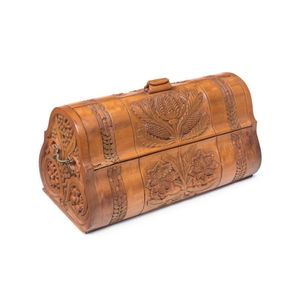George III Sterling Silver Vinaigrette, Birm. 1819
You must be a subscriber, and be logged in to view price and dealer details.
Subscribe Now to view actual auction price for this item
When you subscribe, you have the option of setting the currency in which to display prices to $Au, $US, $NZ or Stg.
- Gilding - Gilding is a method of ornamentation whereby a thin sheet of gold metal is applied to items made of wood, leather, ceramics, glass and silver for decorative purposes.
For furniture including mirrors, the sheet of gold is usually applied over a coating of gesso. Gesso is a mixture of plaster of Paris and gypsum mixed with water and then applied to the carved wooden frames of mirrors and picture frames as a base for applying the gold leaf. After numerous coats of gesso have been applied, allowed to dry and then sanded a coat of "bole", a usually red coloured mixture of clay and glue is brushed on and allowed to dry, after which the gold leaf is applied. Over time parts of the gilding will rub off so the base colour can be seen. In water gilding, this was generally a blue colour, while in oil gilding, the under layer was often yellow. In Victorian times, gilders frequently used red as a pigment beneath the gold leaf.
Metal was often gilded by a process known as fire gilding. Gold mixed with mercury was applied and heated, causing the mercury to evaporate, the long-term effect of which was to kill or disable the craftsman or woman from mercury poisoning. The pursuit of beauty has claimed many victims, not the least of which were the artists who made those pieces so highly sought after today. - George Iii - George III (1738 - 1820) was King of Great Britain and Ireland from 1760 to 1820.
- Sterling Silver - Sterling silver is a mixture of 92.5% pure silver and 7.5% of another metal, usually copper. Fine silver is 99.9% pure silver, and is relatively soft and the addition of the very small amount of copper gives the metal enough strength and hardness to be worked into jewellery, decorative and household objects.
This item has been included into following indexes:
Visually similar items

An Australian folk art sewing box carved with waratahs, wattle, banksia, Sturt desert pea, gum blossoms etc. Late 19th century. 29 cm high, 59 cm wide, 30 cm deep

A rare Victorian sterling silver Windsor Castle top vinaigrette with finger ring and chains, of unusual form with the castle lid hinged on top of a purse shaped body with floral repousse decoration. Gilt interior. Hallmarked Birmingham 1840. Maker Gervase

A Victorian silver match case, tapered oval, engine-turned and with initialled cartouche; Danziger & Isaacs, Birmingham 1865. Height 6 cm

George IV hallmarked sterling silver vinaigrette. Birm. C.1825 (date mark rubbed). Gilded interior, with floral grid, length 3.5g weight 19g
